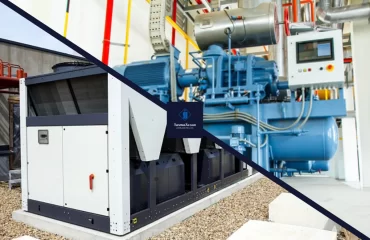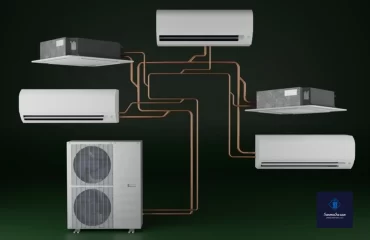One of the most important points in installing a fan coil goes back to its type. Since there are different types of fan coils depending on the location or placement in the market and are divided into types such as ceiling, wall, floor and surface and built-in, naturally the first point to consider the installation is the division of types.
How to install a ceiling fan coil?
There are three types of fan coils: one-way, two-way and three-way, and these names refer to the way their air is distributed in different directions. For this reason, depending on the usage and size of the space, they can be considered quite popular and common. These types of fan coils are placed inside the ceiling and only their panel is located outside the ceiling and is visible.
A single-sided fan coil is usually installed near the wall and corner of the room, near a door or window to direct air to one side. But the four-sided fan coils are installed in the middle of the room so that they can give air to all four sides.
To install the fan coil, it is necessary to check whether these two parts of the panel and the main body are connected to each other from the factory side and whether they are the same or not. If the two are connected, installation will be more difficult and requires more precision. Because their front part or panel is made of plastic and is fragile. Also, this part is one of the most vulnerable and expensive parts of the fan coil due to its internal control section. In this way, the fan coil needs to be installed layer by layer from a greater depth and gradually reach the most superficial layer, which is the panel. When installing ceiling fan coils, it is important that the fan coil is installed completely horizontally and level.
Installation of built-in ceiling fan coil
Overhead fan coils used to take up a lot of space on the roof due to their large size and are practically obsolete today. In this way, built-in ceiling fan coils have replaced them, which are installed in front of the wall and the closest point to the ceiling, and only their panel is visible.
Wall fan coil installation guide
Since the wall fan coil is mounted on the wall, it needs a small amount of demolition to fit the pipes inside the wall.
Also, when installing wall fan coils, care must be taken to ensure that the wall is strong enough and its surface is smooth. In this case, the fan coil must be installed at a distance of 10 cm from the wall. Also, depending on the height of the wall and the distance from the floor to the ceiling, the wall fan coil must be installed in a proper ratio with the ceiling and floor. Because the range of the fan coil is not so high and it is about 6 meters. This 6 meters should be located in a suitable place at the height of the ceiling to meet the heating or cooling needs of people. Placing a wall fan coil at the wrong height can only heat and cool the floor or ceiling and have no effect on the rest of the environment.
How to install a standing ground fan coil?
Ground fan coils are placed on the ground by the bases inside the fan coil shopping cart and are also connected to the wall from behind. The installation of the standing fan coil is such that first the internal contents of the fan coil are in place and then the fan coil cabinet is connected to the continuation of its body. Ground fan coils are usually used when there is a limit to the installation of other fans, such as suspended ceilings, which are not capable of holding ceiling fan coils. Because in any direction, this model of fan coil is located on the ground and occupies some of the volume of the room. But despite all this, ground fan coils are very easy to install and therefore have advantages and disadvantages.
Carefully drain the fan coil, a significant case in the installation
Water leakage due to condensation or distillation on the fan coil coils is one of the key points in the optimal use of the fan coil. In addition to affecting the performance of the fan coil, this water also has a health effect on the health of people who are exposed to fan coil air.
In this way, this accumulation of water provides the place for the growth of microorganisms, and these microorganisms enter the room and space environment by the air circulating in the fan coil, and finally enter the respiratory system of people. Also, this accumulation of water causes physical damage to the wall or ceiling or floor and leads to physical damage. Due to the health of the device and its performance, the air quality produced by the fan coil is reduced by this accumulation of water and some parts of the fan coil are corroded. Therefore, to drain this water, drain pipes must be considered during installation. This water collects in the drain tray or leads to the drain pipes or must be directed to the drain pipes by a pump.
To install this pipe, you must pay attention to its slope in all directions and its open end to drain water. Naturally, it is better to test the function of this pipe for draining water when installing the fan coil.
General safety tips when installing a fan coil
The fan coil is not a complicated device, but it must be installed properly so as not to cause small and large problems during use and over time. To install the fan coil, it is necessary to pay attention to the following point:
Observe the safety distance: It is necessary that there is at least one meter distance between the fan coil and other devices. No object should obstruct the air inlet and outlet of the fan coil.
Lack of obstruction in the flow of air in the fan coil: which is similar to the previous case and emphasizes the absence of a body as an obstacle to air circulation.
Avoid heating devices and direct heat, even direct sunlight.
Avoid wet areas or direct water cover.
Check the available voltage with the appropriate voltage of the device.
Check the health of the fan coil before installing it.
Bend the pipes properly and prevent them from breaking.
Performance test and check for water leakage.

 English
English  فارسی
فارسی 



